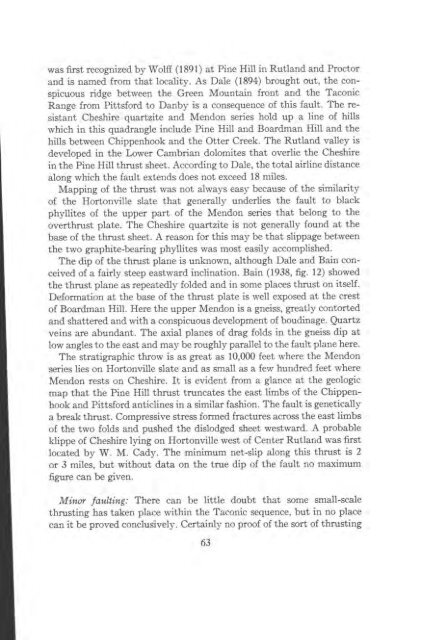STRATIGRAPHY AND STRUCTURE CASTLETON AREA VERMONT
STRATIGRAPHY AND STRUCTURE CASTLETON AREA VERMONT
STRATIGRAPHY AND STRUCTURE CASTLETON AREA VERMONT
Create successful ePaper yourself
Turn your PDF publications into a flip-book with our unique Google optimized e-Paper software.
was first recognized by Wolff (1891) at Pine Hill in Rutland and Proctor<br />
and is named from that locality. As Dale (1894) brought out, the conspicuous<br />
ridge between the Green Mountain front and the Taconic<br />
Range from Pittsford to Danby is a consequence of this fault. The resistant<br />
Cheshire quartzite and Mendon series hold up a line of hills<br />
which in this quadrangle include Pine Hill and Boardman Hill and the<br />
hills between Chippenhook and the Otter Creek. The Rutland valley is<br />
developed in the Lower Cambrian dolomites that overlie the Cheshire<br />
in the Pine Hill thrust sheet. According to Dale, the total airline distance<br />
along which the fault extends does not exceed 18 miles.<br />
Mapping of the thrust was not always easy because of the similarity<br />
of the Hortonville slate that generally underlies the fault to black<br />
phyllites of the upper part of the Mendon series that belong to the<br />
overthrust plate. The Cheshire quartzite is not generally found at the<br />
base of the thrust sheet. A reason for this may be that slippage between<br />
the two graphite-bearing phyllites was most easily accomplished.<br />
The dip of the thrust plane is unknown, although Dale and Bain conceived<br />
of a fairly steep eastward inclination. Bain (1938, fig. 12) showed<br />
the thrust plane as repeatedly folded and in some places thrust on itself.<br />
Deformation at the base of the thrust plate is well exposed at the crest<br />
of Boardman Hill. Here the upper Mendon is a gneiss, greatly contorted<br />
and shattered and with a conspicuous development of boudinage. Quartz<br />
veins are abundant. The axial planes of drag folds in the gneiss dip at<br />
low angles to the east and may be roughly parallel to the fault plane here.<br />
The stratigraphic throw is as great as 10,000 feet where the Mendon<br />
series lies on Hortonville slate and as small as a few hundred feet where<br />
Mendon rests on Cheshire. It is evident from a glance at the geologic<br />
map that the Pine Hill thrust truncates the east limbs of the Chippenhook<br />
and Pittsford anticlines in a similar fashion. The fault is genetically<br />
a break thrust. Compressive stress formed fractures across the east limbs<br />
of the two folds and pushed the dislodged sheet westward. A probable<br />
klippe of Cheshire lying on Hortonville west of Center Rutland was first<br />
located by W. M. Cady. The minimum net-slip along this thrust is 2<br />
or 3 miles, but without data on the true dip of the fault no maximum<br />
figure can be given.<br />
Minor faulting: There can be little doubt that some small-scale<br />
thrusting has taken place within the Taconic sequence, but in no place<br />
can it be proved conclusively. Certainly no proof of the sort of thrusting<br />
63













